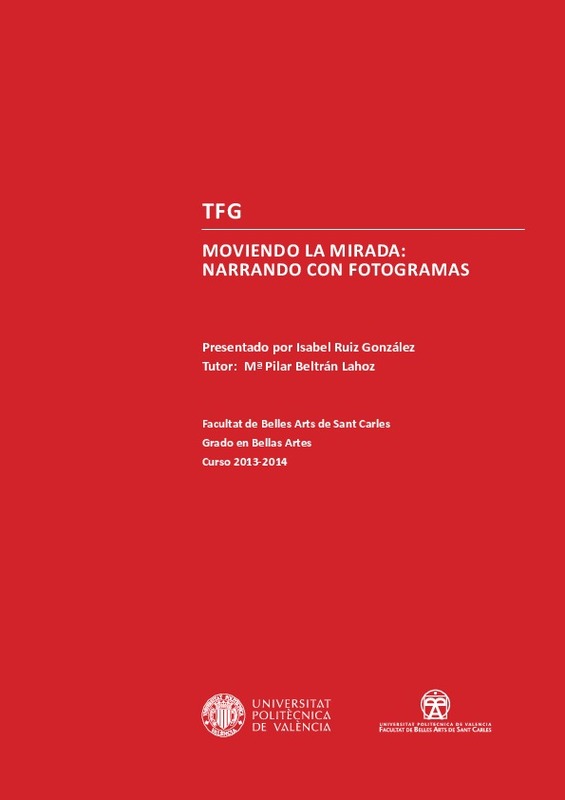JavaScript is disabled for your browser. Some features of this site may not work without it.
Buscar en RiuNet
Listar
Mi cuenta
Estadísticas
Ayuda RiuNet
Admin. UPV
Moviendo la mirada: narrando con fotogramas
Mostrar el registro sencillo del ítem
Ficheros en el ítem
| dc.contributor.advisor | Beltrán Lahoz, Maria Pilar
|
es_ES |
| dc.contributor.author | Ruiz González, Isabel
|
es_ES |
| dc.date.accessioned | 2015-04-23T10:53:51Z | |
| dc.date.available | 2015-04-23T10:53:51Z | |
| dc.date.created | 2014-06 | |
| dc.date.issued | 2015-04-23 | |
| dc.identifier.uri | http://hdl.handle.net/10251/49175 | |
| dc.description.abstract | This Degree Dissertation (TFG) grew from my interest in cinema, more specifically from the interest in the narrative techniques that the film language uses to tell stories since the early days of the moving image. After studying various subjects related to film analysis, the static image (picture techniques) and graphic expression, I chose to use charcoal and pencil as graphical techniques for the drawings I present here. The project is involved in the creation of a narrative story, departing from cinematographic elements - the shot and the frame-, and translating them into a graphical language. Then, this TFG presents five drawings that have as departing point stills captured from different films; These drawings, decontextualized from their original environment ,have the ability to create a new narrative. The structure of the FG is divided in two main sections: a theoretical section that reflects on the relationship between cinema and painting and explores the different types of shot and the importance of the ellipsis. And another section focused on the development of the practical project and the process of it. | es_ES |
| dc.description.abstract | El presente Trabajo Final de Grado (TFG) parte de mi interés por el cine, y más concretamente, por las técnicas narrativas que el lenguaje cinematográfico utiliza para contar historias desde los inicios de la imagen en movimiento. Tras cursar diferentes asignaturas relacionadas con el análisis cinematográfico, la imagen estática (fotografía/técnicas fotográficas) y la expresión gráfica, opté por utilizar el carboncillo y el lápiz conté como técnica gráfica para los dibujos realizados. El proyecto se mueve en la creación de una historia narrativa de ámbito cinematográfico, desde un lenguaje gráfico e incluyendo elementos propios del cine: el plano y el encuadre. Así pues, el TFG presenta una serie de dibujos que como base referencial toman fotogramas de diferentes películas ; descontextualizados de su entorno original y puestos en relación entre sí, obteniendo la capacidad de crear una nueva narración. La estructura del TFG se divide en dos apartados principales: un apartado teórico que reflexiona acerca de las relaciones entre cine y pintura e indaga en los diferentes tipos de plano y en la importancia de la elipsis. Y otro apartado centrado en el desarrollo del proyecto práctico y en los antecedentes previos a éste. | es_ES |
| dc.format.extent | 34 | es_ES |
| dc.language | Español | es_ES |
| dc.publisher | Universitat Politècnica de València | es_ES |
| dc.rights | Reconocimiento - No comercial - Sin obra derivada (by-nc-nd) | es_ES |
| dc.subject | Narración | es_ES |
| dc.subject | Fotograma | es_ES |
| dc.subject | Dibujo | es_ES |
| dc.subject | Carboncillo | es_ES |
| dc.subject | Cine | es_ES |
| dc.subject.classification | PINTURA | es_ES |
| dc.subject.other | Grado en Bellas Artes-Grau en Belles Arts | es_ES |
| dc.title | Moviendo la mirada: narrando con fotogramas | es_ES |
| dc.type | Proyecto/Trabajo fin de carrera/grado | es_ES |
| dc.rights.accessRights | Abierto | es_ES |
| dc.contributor.affiliation | Universitat Politècnica de València. Departamento de Pintura - Departament de Pintura | es_ES |
| dc.contributor.affiliation | Universitat Politècnica de València. Centro de Investigación Arte y Entorno - Centre d'Investigació Art i Entorn | es_ES |
| dc.contributor.affiliation | Universitat Politècnica de València. Facultad de Bellas Artes - Facultat de Belles Arts | es_ES |
| dc.description.bibliographicCitation | Ruiz González, I. (2014). Moviendo la mirada: narrando con fotogramas. http://hdl.handle.net/10251/49175. | es_ES |
| dc.description.accrualMethod | Archivo delegado | es_ES |
Este ítem aparece en la(s) siguiente(s) colección(ones)
-
BBAA - Trabajos académicos [5086]
Facultad de Bellas Artes






